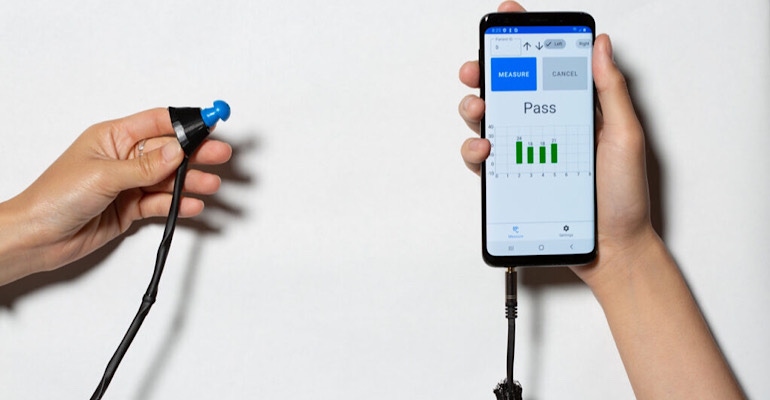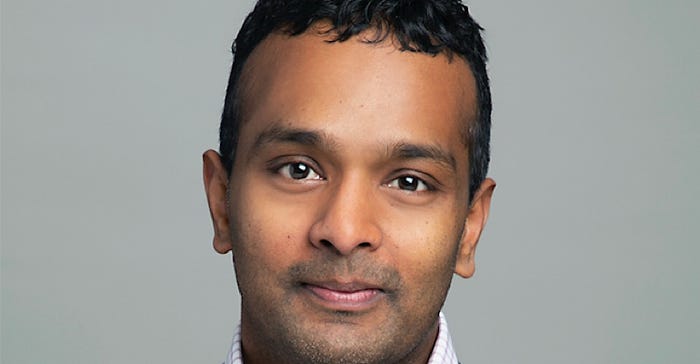University of Washington Lab ‘Pays It Forward’ with Democratized Health Tech
An inventor shares his vision, on democratizing healthcare and medtech technologies.
December 29, 2022

Shyam Gollakota says his drive to bring life-changing health technologies to people who otherwise would never have access to them may have begun in his childhood in his native India.
“My grandmother had severe hearing loss and I kind of joke that the reason I am typically very loud stems from that,” Gollakota said. “We couldn’t afford to get her hearing aids. We were a lower middle-class family, so it’s very close to my personal experience.”
Gollakota rose from his childhood surroundings to become the director of the mobile intelligence lab at the University of Washington’s Paul G. Allen School of Computer Science and Engineering. And, in the past year, he and his students and colleagues have demonstrated at least two technologies that take the expense and inconvenience of commonplace tests out of the clinic and straight into a user’s hands. These technologies, still in demonstration phases, could ultimately prove to be a profound benefit in low- and middle-income nations.
One of those technologies uses a smartphone’s haptic motor and camera to measure blood coagulation time. The other, perhaps influenced by his grandmother’s experience, uses a phone and off-the-shelf earbuds to measure newborn infants’ hearing.
“There is no newborn hearing screening in India or Kenya,” Gollakota said. “In the U.S. they have it in hospitals across the country, which is good. If you can discover that someone is having hearing loss early on, you can intervene and improve the quality of life, but that doesn’t exist in the rest of the world.”
Indeed, with the cost of some otoacoustic emission testing (OAE) equipment exceeding $5,000, testing newborns’ hearing in low-income nations is simply not possible. Gollakota’s team’s invention costs approximately $10 and uses an off-the-shelf microphone and off-the-shelf earbuds connected to a smartphone through a headphone jack. It sends two pure tones through each of the earbuds and algorithmically detects the distortion-product OAEs generated by the cochlea and recorded via the microphone. In a clinical study with 114 young patients., some infants younger than six-months-old and some with known existing hearing loss, the device detected hearing loss with 100 percent sensitivity and 88.9% specificity, which they said is comparable to the performance of a commercial device.

Inspiration, improvisation, innovation
Though he concedes some projects the lab undertakes are inspired by personal experience, others are the result of simple curiosity and ongoing brainstorming by the lab researchers and clinical colleagues.
“We just keep asking basic questions and aren’t afraid of looking stupid,” he said. “It’s OK not to know stuff. You learn from the experts around you.”
For instance, he said he did not know until his colleagues began discussing the OAE device that the inner ear generates sounds.
“That kind of blew my mind when I heard about it,” he said. “You think of your ear as something like a microphone that just receives sounds. The fact your cochlea can generate sounds? Come on, that’s fascinating.”
The lab team modified the concept used on commercial OAE equipment by fitting each of two earbuds with one of the two tones that elicit a response from the cochlea and attaching a microphone to them in a probe that is placed in the patient’s ear. They also coded the device’s algorithms to work with heightened amounts of background noise.
The device is now being tested in a newborn hearing screening project in Kenya. The researchers teamed up with a group from the university’s global health department, the University of Nairobi and the Kenya Ministry of Health to create the project “Toward Universal Newborn and Early Childhood Hearing Screening in Kenya (TUNE).
Paying it forward sometimes
One of the basic premises behind the lab’s research is that much of the capability of clinical equipment designed 20 or 30 years ago, but still in wide use, can be emulated much more economically on smartphones, which receive regular upgrades in both software and hardware on nearly an annual basis.
“One of the things that is really helpful working with mobile technology and software is that you can prototype extremely quickly, and that is exactly the promise of digital health,” he said. “The pace with which you can build things that are useful is actually much quicker than if you had to develop your own specific hardware from the ground up.”
The promise of the mobile technology also allows the lab to create a mix of technologies, some of which they essentially donate by making the code open source; both the coagulation testing and hearing test technologies have been released in that way. Others, such as a breathing analysis technology that was purchased by Google and another that can aid diagnosis of ear infections, have gone the commercial startup route.
And, while he feels labs such as his are introducing a form of competition to established technologies, he also thinks it is all part of a much larger trend that will compel vendors of those technologies to step up their own pace of innovation.
“I think the fact we have these mobile technologies is basically an opportunity to democratize these technologies that haven’t seen much innovation in the last couple of decades,” he said. “I wouldn’t be surprised if in the next five years, the bigger manufacturers include OAE technology on the earbuds themselves. People do pay attention to these papers.”
And we can expect more innovations from the lab: “We are growing all the time,” he said. “The way to keep yourself new is to work with people who have new ideas they bring to the lab.”
About the Author(s)
You May Also Like

.png?width=300&auto=webp&quality=80&disable=upscale)
